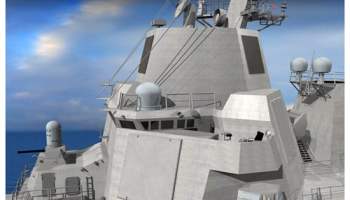If you consider e.g. the Dutch APAR (X-band) and SMART-L (S-Band) set up, on much smaller hulls, with e.g the former in an integrated mast (I-MAST 500), then you know you can have an effective package in a small space.
If you look at the AB you can use not only the area atop the bridge but also the area behind the rear stack. Esp. if you relocate or delete the rear Phalanx (one could well replace this by a SeaRam on both port and starboard on the most forward part of the structure housing the hangar) as well as the AN/SPG-62s, you could well place a maststructure there to incorporate X-band with 2, 3 or perhaps even 4 arrays.
You don't necessarily need to go this way:
PS: Why are the AN/SPG-62s retained upon installation of ICWI capable X-band AESA??? After all: "the X-band radar is to provide horizon search, precision tracking, missile communication
and terminal illumination of targets. The S-band and X-band sensors will also
share functionality including radar navigation, periscope detection, as well as
missile guidance and communication."
https://en.wikipedia.org/wiki/AN/SPY-6
APAR (X-band) on Dutch LCF: a very compact mast structure.
Apar Blk 2: Thales' new X-band multi-function radar, successor to the proven APAR (the first naval AESA radar).
https://www.thalesgroup.com/en/worldwide/defence/apar-active-phased-array-multifunction-radar
http://vanguardcanada.uberflip.com/i/699741-vanguard-junejuly-2016/1





 I forget the decimal
I forget the decimal













